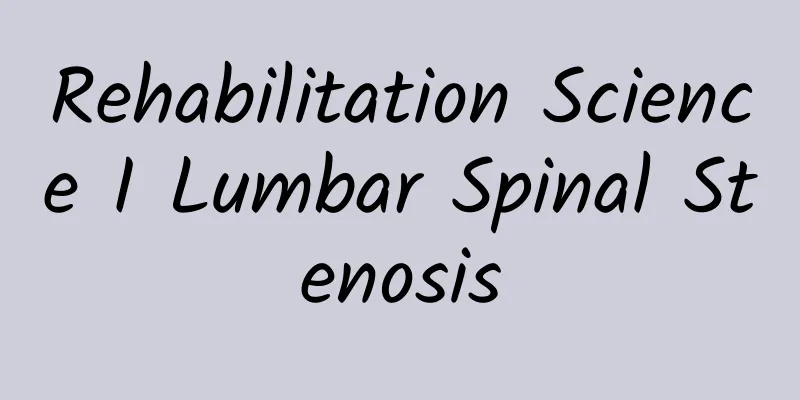Rehabilitation Science I Lumbar Spinal Stenosis

|
What is lumbar spinal stenosis Lumbar spinal stenosis refers to a disease in which the morphology and tissue structure of the lumbar vertebrae and soft tissues (facet joints, lamina, yellow ligament, intervertebral disc, etc.) change due to various reasons, leading to the stenosis of the central spinal canal, nerve root canal, and intervertebral foramen , causing compression of the nerve roots and (or) cauda equina, and causing a series of clinical symptoms. What is the spinal canal The spine is made up of pieces of bones with holes, and these bones with holes are stacked together to form the spinal canal. The spinal cord mainly runs inside the spinal canal, and the spinal cord branches out into many nerve roots. These nerve roots go out through the intervertebral foramina on both sides of the spinal canal. The anterior wall of the vertebral canal is composed of the back of the vertebral body, the posterior edge of the intervertebral disc and the posterior longitudinal ligament , the posterior wall is composed of the lamina, yellow ligament and facet joints, and the lateral walls are composed of the pedicles and intervertebral foramina . Causes of Lumbar Spinal Stenosis Spinal stenosis can be divided into two types: congenital and acquired. 1. Developmental lumbar spinal stenosis : This type of spinal stenosis is caused by congenital developmental abnormalities, including congenital spinal stenosis caused by nutrition, trauma, etc. Most people may not have any symptoms at the beginning, but after middle age, due to some aging or damage to the spine, symptoms and signs of spinal stenosis will appear. 2. Spinal stenosis caused by acquired factors : This is mainly caused by the degeneration of the spine, including the following aspects: 01 Herniated disc: When a disc herniates, the protruding disc takes up space in the spinal canal, causing spinal canal stenosis. 02 Hypertrophy of the yellow ligament and the posterior longitudinal ligament: When the spine degenerates and becomes unstable, the stress on the yellow ligament and the posterior longitudinal ligament increases, often leading to their degeneration or rupture. The long-term injury and repair process will inevitably cause the yellow ligament and the posterior longitudinal ligament to thicken, and the space in the spinal canal will become smaller, leading to spinal stenosis. 03Vertebral facet joint hyperplasia: The so-called facet joint refers to the joint between two vertebrae. The surface of normal facet joints is cartilaginous and relatively free to move. However, when the spine degenerates, the cartilage on the joint surface wears away, causing friction between bones, resulting in bone hyperplasia. (The principle is similar to how our hands often work and rub to form calluses.) These hyperplastic bones occupy the space of the spinal canal or intervertebral foramen, resulting in spinal stenosis. 04Spondylolysis : When a vertebral body is dislocated and slipped, the spinal canal becomes further narrowed because the upper and lower spinal canals shift forward and backward. 05Spinal trauma: When the spine is traumatized, especially when the trauma is severe and causes spinal fracture or dislocation, it often causes spinal stenosis. Symptoms of Lumbar Spinal Stenosis 01 Limited lumbar extension and pain: When the lumbar spine moves from a neutral position to an extended position, the small joint capsule and yellow ligament at the back of the spinal canal squeeze into the spinal canal, the length of the spinal canal shortens, and the intervertebral foramen narrows, resulting in the narrowing of the effective space inside the spinal canal and the intervertebral foramen, which causes various symptoms. 02Intermittent claudication: After walking a certain distance (several meters to several hundred meters), the patient will experience soreness in the waist, leg pain, numbness in the lower limbs, weakness and limping on one or both sides. After bending over, squatting or sitting down to rest for a few minutes, the patient can continue to walk, but the distance is shorter than that of a normal person. Because of the intermittent period, it is called intermittent claudication. The interval distance of claudication can gradually shorten as the disease gradually worsens, and severe patients cannot walk on the ground. 03Cauda equina compression: Symptoms and signs of the saddle area and sphincter symptoms may appear. In severe cases, it may lead to incontinence of stool and urine, sexual dysfunction, and even incomplete paralysis of the lower limbs. Auxiliary examination for lumbar spinal stenosis 01 X-ray film : In patients with developmental or mixed spinal stenosis, the main manifestations are small sagittal diameter of the spinal canal, abnormal hypertrophy of the lamina, articular process and pedicle, small joints on both sides shifted to the midline, and narrow interlaminar space; degenerative patients have obvious bone hyperplasia. The sagittal diameter of the spinal canal can be measured on the lateral film. Those below 14mm indicate spinal stenosis, and those between 14 and 16mm are relatively narrow. Symptoms may occur under additional factors. The ratio of the spinal canal to the vertebral body can also be used to determine whether it is narrow. 02 CT, CTM and MRI examinations : CT examination can show the cross-sectional morphology of the spinal canal and root canal, but it is not easy to understand the overall picture of stenosis. In addition to understanding the bony structure, CTM can also clarify the compression of the dura mater sac and is currently more widely used. In addition, MRI examination can show the overall picture of the lumbar spinal canal. Currently, most orthopedic physicians have used it as a routine examination. 03Myelography : Puncture and injection of drugs are often performed in the L2 and L3 intervertebral spaces. At this time, pointed interruptions, comb-like interruptions, and bee-waist-like changes may appear, which can basically give an overall picture of the stenosis. Since this examination is invasive, it is rarely used nowadays. Treatment of lumbar spinal stenosis Lumbar spinal stenosis is not the same as lumbar spinal stenosis. Many people can see lumbar spinal stenosis on the film, but there are no discomfort symptoms. In this case, no treatment is needed. Only when there is lumbar spinal stenosis on the image and there are corresponding symptoms, we call it lumbar spinal stenosis, and only then does it need treatment. 01Bed rest: During the acute phase, when symptoms are more severe, bed rest is a very effective treatment. Generally, bed rest for 3 to 5 weeks, keeping warm and avoiding long periods of sitting can reduce and relieve back and leg pain, because bed rest can reduce the load on the intervertebral disc and the traumatic inflammation of the intervertebral joints, thereby relieving symptoms. 02Oral medication: (1) Non-steroidal anti-inflammatory drugs: mainly used for anti-inflammatory and analgesic effects in the acute phase. (2) Dehydration drugs: also called detumescent drugs. They can effectively eliminate edema of the nerve roots and relieve symptoms. (3) Nerve nutrition drugs: such as methylcobalamin tablets, etc. 03Rehabilitation exercises and physical therapy: Rehabilitation exercises can enhance the stability of the spine and prevent recurrence of the disease. Wearing a waist belt while doing rehabilitation exercises can also effectively relieve spinal stenosis. Physical therapy can effectively eliminate nerve root edema and promote blood circulation. 04Surgery : Surgery is one of the effective methods for treating degenerative lumbar spinal stenosis. Most clinical scholars believe that for patients with severe lumbar spinal stenosis, obvious symptoms such as lower limb pain, intermittent pacing, cauda equina syndrome, which seriously affect the patient's daily life and work, and who have no significant relief after 3-6 months of conservative treatment, and whose general condition can tolerate surgery, surgical treatment should be performed. |
Recommend
What are the symptoms of adnexal cysts?
Adnexal cyst is also a common cyst. Adnexal cyst ...
What to do if pregnant women have low thyroid hormone
Thyroid hormone is a physiological substance in t...
How many days does it take from conception to implantation?
People who are preparing for pregnancy usually ho...
Women's facial care methods
I believe everyone knows the importance of face t...
What to do if you suffer from insomnia during late pregnancy
Pregnant women will encounter many problems durin...
Silver Age Science | What is suitable for the elderly to eat? What is not suitable to eat? This article tells you——
#Thousands of IPs Create Science Popularization# ...
Is it harmful to be angry at the fifth month of pregnancy?
Is it okay to get angry when you are five months ...
37 weeks pregnant lower abdominal pain
The 37th week of pregnancy is almost the time for...
What are the symptoms of vulvitis in young girls
Many friends may not have heard of this disease, ...
Can I get pregnant if I have sex eight days after my period?
It is also not easy to get pregnant if you have y...
8 health tips for women's private parts care
1. Use condoms instead of birth control pills Con...
Is it OK to wear a tampon while swimming?
Many female friends may be very unfamiliar with t...
What causes uterine myositis?
Myometritis is a serious disease for women. When ...
Chest pain but no menstruation
Many people define chest pain as a manifestation ...
There are five tricks to maintain your uterus
To maintain the uterus, you must first pay attent...









